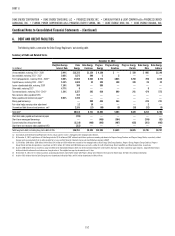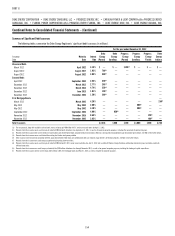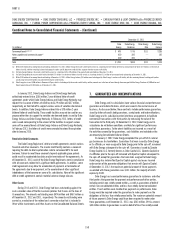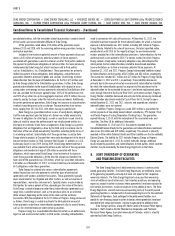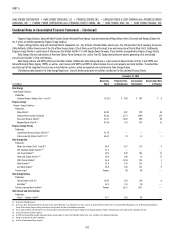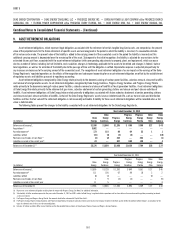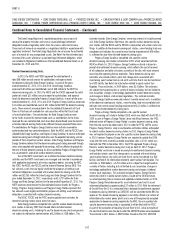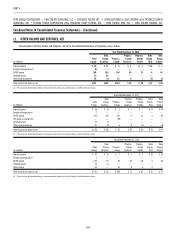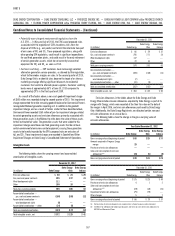Duke Energy 2012 Annual Report Download - page 177
Download and view the complete annual report
Please find page 177 of the 2012 Duke Energy annual report below. You can navigate through the pages in the report by either clicking on the pages listed below, or by using the keyword search tool below to find specific information within the annual report.
157
PART II
Combined Notes to Consolidated Financial Statements – (Continued)
DUKE ENERGY CORPORATION • DUKE ENERGY CAROLINAS, LLC • PROGRESS ENERGY, INC. • CAROLINA POWER & LIGHT COMPANY d/b/a PROGRESS ENERGY
CAROLINAS, INC. • FLORIDA POWER CORPORATION d/b/a PROGRESS ENERY FLORIDA, INC. • DUKE ENERGY OHIO, INC. • DUKE ENERGY INDIANA, INC.
The Duke Energy Registrants have the ability under certain debt facilities
to call and repay the obligation prior to its scheduled maturity. Therefore, the
actual timing of future cash repayments could be materially different than as
presented above.
Available Credit Facilities
In November 2011, Duke Energy entered into a $6 billion, 5-year master
credit facility, expiring in November 2016, with $4 billion available at closing
and the remaining $2 billion became available July 2, 2012, following the
closing of the merger with Progress Energy. In October 2012, the Duke Energy
Registrants reached an agreement with banks representing $5.63 billion of
commitments under the master credit facility to extend the expiration date
by one year to November 2017. Through November 2016, the available credit
under this facility remains at $6 billion. The Duke Energy Registrants each have
borrowing capacity under the master credit facility up to specifi ed sub limits
for each borrower. However, Duke Energy has the unilateral ability at any time
to increase or decrease the borrowing sub limits of each borrower, subject to
a maximum sublimit for each borrower. See the table below for the borrowing
sub limits for each of the borrowers as of December 31, 2012. The amount
available under the master credit facility has been reduced, as indicated in the
table below, by the use of the master credit facility to backstop the issuances of
commercial paper, certain letters of credit and variable rate demand tax-exempt
bonds that may be put to the Company at the option of the holder. As indicated,
borrowing sub limits for the Subsidiary Registrants are also reduced for certain
amounts outstanding under the money pool arrangement.
December 31, 2012
(in millions)
Duke
Energy
(Parent)
Duke
Energy
Carolinas
Progress
Energy
Carolinas
Progress
Energy
Florida
Duke
Energy
Ohio
Duke
Energy
Indiana
Total
Duke
Energy
Facility size $1,750 $1,250 $750 $750 $ 750 $ 750 $ 6,000
Reduction to backstop issuances
Notes payable and commercial paper (195) (300) — — (104) (201) (800)
Outstanding letters of credit (50) (7) (2) (1) — — (60)
Tax-exempt bonds — (75) — — (84) (81) (240)
Available capacity $1,505 $ 868 $748 $749 $ 562 $ 468 $4,900
Short-term Obligations Classifi ed as Long-term Debt
At December 31, 2012 and 2011, variable rate demand tax-exempt
bonds that may be put to the Company at the option of the holder, commercial
paper issuances and money pool borrowings were classifi ed as Long-term debt
on the Consolidated Balance Sheets. These variable rate tax-exempt bonds,
commercial paper issuances and money pool borrowings, which are short-term
obligations by nature, are classifi ed as long term due to Duke Energy’s intent
and ability to utilize such borrowings as long-term fi nancing. As Duke Energy’s
master credit facility has non-cancelable terms in excess of one year as of
the balance sheet date, Duke Energy has the ability to refi nance these
short-term obligations on a long-term basis. The following tables show
short-term obligations classifi ed as long-term debt.
December 31, 2012
(in millions)
Duke
Energy
Duke Energy
Carolinas
Duke Energy
Ohio
Duke Energy
Indiana
Tax-exempt bonds(a)(b)(c)(d) $ 471 $ 75 $ 111 $285
Notes payable and commercial paper(e) 450 300 — 150
Revolving loan(f) 200 — — —
DERF(g) 300 300 — —
Total $1,421 $ 675 $ 111 $435
(a) Of the $471 million of tax-exempt bonds outstanding at December 31, 2012 at Duke Energy, the master credit facility served as a backstop for $240 million of these tax-exempt bonds, with the remaining balance backstopped
by other specifi c long-term credit facilities separate from the master credit facility.
(b) For Duke Energy Carolinas, the master credit facility served as a backstop for the $75 million of tax-exempt bonds outstanding at December 31, 2012.
(c) Of the $111 million of tax-exempt bonds outstanding at December 31, 2012 at Duke Energy Ohio, the master credit facility served as a backstop for $84 million of these tax-exempt bonds, with the remaining balance
backstopped by other specifi c long-term credit facilities separate from the master credit facility.
(d) Of the $285 million of tax-exempt bonds outstanding at December 31, 2012 at Duke Energy Indiana, $81 million were backstopped by Duke Energy’s master credit facility, with the remaining balance backstopped by other
specifi c long-term credit facilities separate from the master credit facility.
(e) Duke Energy has issued $450 million in Commercial Paper, which is backstopped by the master credit facility, and the proceeds are in the form of loans through the money pool to Duke Energy Carolinas and Duke Energy
Indiana as of December 31, 2012.
(f) Duke Energy International Energy’s revolving loan is due in December 2013 with the right to extend the maturity date for additional one year periods with a fi nal maturity date no later than December 2026.
(g) Duke Energy Receivables Finance Company, LLC (DERF) is a wholly owned limited liability company of Duke Energy Carolinas. See Note 18 for further information.







